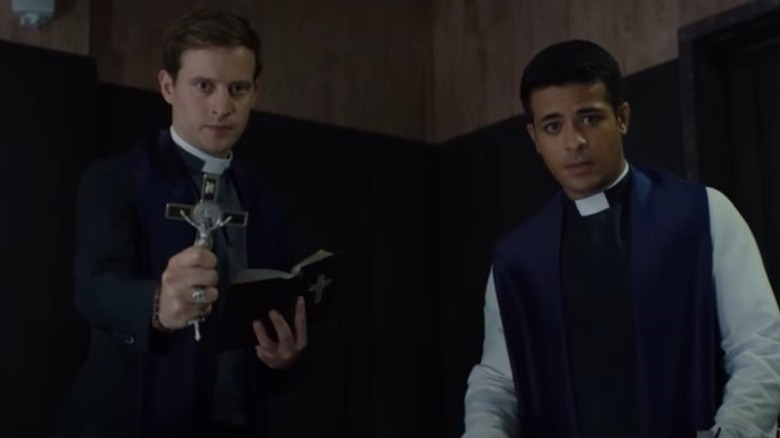Prey For The Devil's New Approach To Exorcism Is A Breath Of Fresh Air
Halloween is the time of year when horror movie fanatics get precisely what they love, the kind of movies that can scare the jeepers out of everyone in the theater. Ever since 1973, when "The Exorcist" proved to studios that audiences were willing to flock to the theater to get scared out of their wits, production companies have tried over and over to recapture the magic of the trailblazing possession film. This season, in the lead-up to Halloween, fans have been treated to scary movies like "Barbarian," "Pearl," "Smile," and "Halloween Ends."
The last release before the holiday is one in the same genre as "The Exorcist," the latest in possession thrillers, "Prey for the Devil." The film follows Sister Ann (Jacqueline Byers) as she enrolls in a school to teach Catholic priests to perform exorcisms on possessed people. She becomes embroiled in the battle for the soul of a young girl and discovers that the demon she is battling is the very same one who tormented her mother years before. The film also stars Virginia Madsen, who is no rookie to the horror genre with roles in "The Prophesy," "Candyman," and "The Haunting in Connecticut." Rounding out the cast is Colin Salmon, who is best known for his roles in "Resident Evil," "24: Live Another Day," and "Arrow."
Movies about possession and exorcisms are a dime a dozen nowadays, and they seem to continue to be on the rise, thanks to the unrelenting success of James Wan's "Conjuring Universe." But director Daniel Stamm wasn't happy with just doing another run-of-the-mill exorcism flick; he believes his story is different. He sat down with Bloody Disgusting to describe what he feels sets his film apart from the rest of the genre.
The film challenges the status quo
First and foremost, "Prey for the Devil" challenges Hollywood's standard of possession movies. All of them have one primary constant that exists mainly out of tradition. The exorcists are men. Catholic doctrine traditionally only allowed ordained priests to perform exorcisms, and since women were relegated to convents as nuns, they weren't typically allowed to battle demons in the way men would. That was before Daniel Stamm got his hands on the film.
In the interview, Stamm spoke about his version of the strong female character. "The 'strong female protagonist' is a buzzword that is being thrown around a lot, and I rarely have the feeling that it's really paid off. You can hail some female Marvel characters as feminist icons, yet they are really just punching bad guys the same way their male counterparts do. It's not like they are coming in with a new perspective and challenge the status quo." He goes on to elaborate how Sister Ann points out that the majority of their work is focused on their own vanity, that they do what they do simply to be hailed as warriors for God. She turns the tide, returning the focus to the possessed person, not letting the Devil use her vanity as a distraction.
Stamm also elaborates on why this approach is different, why her being a female exorcist is compelling, not just as a gimmick. "A story about a male exorcist has one point of conflict: church vs. demon. But a female exorcist needs to fight the demon AND the church to whose doctrine she poses a much bigger threat than the Devil himself does." Laurie Strode isn't the only strong female character this Halloween, and Michael Myers may prove an easy opponent compared to the Devil himself.

